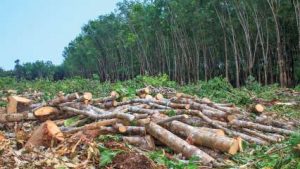2022 Forest Declaration Assessment:

The 2022 Forest Declaration Assessment was published, showing that the Deforestation rates worldwide declined only modestly in 2021 by 6.3 % compared to the 2018-20 baseline.
- Some 145 countries affirmed their commitment to halt and reverse forest loss and land degradation by 2030 at the 26th UN Climate Change Conference of the Parties (COP26) in Glasgow (2021).
- Forest Declaration Assessment publishes annual updates on progress toward global forest goals.
- In 2014, the New York Declaration on Forests (NYDF) was adopted as a political declaration calling for the end of natural forest loss and the restoration of 350 million hectares of degraded landscapes and forestlands by 2030.
Findings:
- Brazil was the world’s largest contributor to deforestation in 2021.
- The country marked a 3% rise in the rate of deforestation in 2021 compared to the baseline 2018-2020.
- Although Brazil didn’t show a large increase, its total deforestation rates each year remained high — making it the world’s largest contributor.
- Bolivia and the Democratic Republic of the Congo underwent deforestation at 6 % and 3 %, respectively.
- Global tree cover increased by 130.9 million hectares over the past two decades.
- Three-quarters of the global gain was concentrated in 13 countries.
- The most significant improvements were observed in Russia (28.4 %), Canada, the United States, Brazil, and China.
- China showed the largest net gain in tree cover — 2.1 million hectares (Mha). India also marked a gain of 0.87 Mha in tree cover.
- Globally, 118.6 Mha of the total tree cover gain is likely due to natural regeneration and assisted natural regeneration that occurred outside plantations.
- Gabon reduced deforestation by 28% in 2021 compared to 2018-20.
- The country implemented measures to combat illegal logging and the enforcement of protected areas.
- Indonesia reduced deforestation after implementing the forest moratorium and improved enforcement measures.
- The moratorium, which covers around 66 million hectares of primary forest and peatland (terrestrial wetland ecosystems), was first introduced in 2011 and has been renewed regularly as part of the efforts to reduce emissions from fires caused by deforestation.
- In Brazil, the decline in deforestation rates between 2004 and 2012 can be partly attributed to the coordinated implementation of the Action Plan for the Prevention and Control of Deforestation in the Amazon.
- It created protected areas and effective monitoring systems.
- Recent years have seen legal interventions in the European Union, Ecuador and India to protect forests.
- In 2021, a constitutional court in Ecuador upheld the rights of nature enshrined in the country’s constitution.




